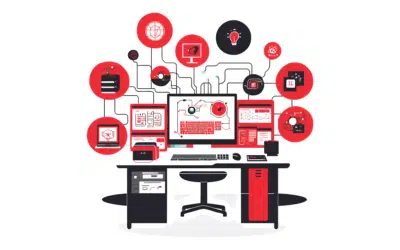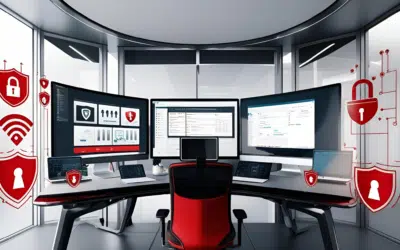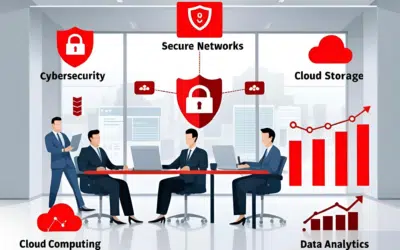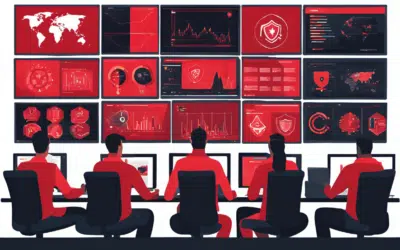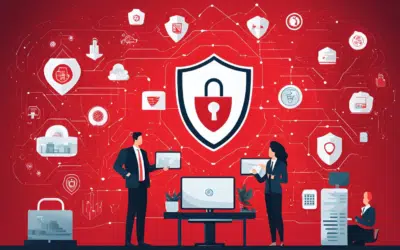Cybersecurity is an essential practice for individuals and organizations in our interconnected world. The best cybersecurity doesn’t have to be complicated. Small yet meaningful changes can reinforce your business and protect employees, customers, and company IP. This post outlines fundamental steps to bolster your defenses against cyber threats that every business can, and should, do.
Taking these proactive measures helps protect your digital identity and assets. Implementing strong security practices like securing your Wi-Fi network and performing regular data backups ensures your systems remain resilient against potential cyber-attacks.
Change your passwords right now!
Cybersecurity is a constant battle against bad actors. One of the simplest yet most effective defenses you can employ is changing default passwords on your devices and systems before they connect to the network. This is not just good practice. It’s a crucial barrier against initial access attempts by cybercriminals.
Why You Should Act:
- Prevent Initial Access: Default passwords are easy prey for hackers.
- Hinder Lateral Movement: If they breach one device, complex, unique passwords make it harder to jump to another.
- Mandatory Policy: An organization-wide policy to change default passwords protects everyone.
Remember, many devices, especially smartphones, prompt you to set new passwords by default. However, not all technology does, leaving a gaping hole in your digital defenses. Never assume! Always reset those passwords yourself.
Vendor Vigilance Checks:
- Ask vendors about default passwords.
- Ensure they adhere to robust security measures.
Default passwords should be a relic of the past. In a world rife with cyber threats, your proactive steps in safeguarding your digital identity are invaluable. So, whether it’s your personal device or a fleet in your organization, take a moment now to fortify your cyber sanctuary.
Enable Two-Factor Authentication
Two-factor authentication (2FA) strengthens account security beyond the traditional password. It does so by introducing a secondary element—either a code or a physical device—that must be supplied during login.
Benefits of Two-Factor Authentication:
- Additional Security Layer: Prevents unauthorized access even if login credentials are compromised.
- Reduction of Exploitation Risk: Hardware-based tokens, like FIDO or Public Key Infrastructure, offer top-notch security.
- Versatility: App-based soft tokens offer a reliable alternative, superior to SMS verification methods.
Tech companies, understanding the vast array of cyber threats, consider the adoption of 2FA a paramount cybersecurity practice. It forms an integral part of their self-imposed cybersecurity plans to protect digital systems and essential services. Thankfully, 2FA is available to every company willing to adopt it.
Action Items for Implementing 2FA:
- Encourage the use of hardware-based tokens for maximum security.
- Use app-based tokens where hardware tokens are impractical.
- Follow CISA guidelines and integrate 2FA to safeguard accounts.
Tech leaders and security teams understand that 2FA is an essential component of effective security practices, playing a crucial role in thwarting cyber incidents and reinforcing cybersecurity efforts.
Train your team on Phishing Attempts
Recognizing and defending against phishing attempts is a cornerstone of robust cybersecurity. Hacker tactics like phishing are prevalent, aiming to infiltrate systems through deceptive emails. Embedding cybersecurity awareness through training during new-hire orientations is essential in cultivating a vigilant company culture.
Adopting short, regular instructional sessions on phishing—with periodic reviews—proves to be more effective than infrequent, lengthy training. Collaboration between IT and HR departments is critical. Together, they can craft compelling educational content, tailored to meet employee needs and enhance engagement.
Security policies must highlight the criticality of identifying and reporting phishing attempts. Employees, informed through these policies, become empowered to proactively combat cyber threats. Implementing these steps ensures that teams are not only knowledgeable but also prepared to take swift action against phishing schemes.
Key Elements of Effective Phishing Awareness Training:
- Frequency: Regular, bite-sized training
- Content Collaboration: IT and HR develop engaging materials
- Policy Integration: Clear guidelines on identifying and reporting
- Culture of Awareness: Starting from onboarding
Investing in continuous phishing awareness training is the defense line that fortifies an organization against cyber-attacks.
Apply Software Updates and Patches
In the realm of cybersecurity, vigilant software management is a critical defense against a myriad of cyber threats. Software updates and patches play a significant role in maintaining the health and security of digital systems. They are often released to address specific security vulnerabilities that have been discovered since the last version of the software.
To mitigate cybersecurity risks, it is paramount to ensure that all devices have antivirus software installed, with automatic updates enabled. This auto-update function is not limited to antivirus programs. It extends to operating systems, web browsers, and various other applications crucial to your digital operations.
Neglecting software updates can leave systems unprotected and susceptible to cyber incidents, including ransomware and social engineering attacks. Therefore, employing robust security practices, such as configuring devices to accept and install updates automatically, is not just recommended — it’s essential.
Secure Your Wi-Fi Network
In today’s interconnected world, cyber threats are evolving, making it crucial to safeguard your Wi-Fi network against potential cyber incidents. Encryption is your first line of defense as it scrambles data to prevent unauthorized eavesdropping. Configure your access point or router to keep your network name (SSID) out of sight; invisibility adds a layer of security.
Ensure that access to your router is password-protected. Strong passwords are fundamental to cyber risk management and deter bad actors from gaining initial access. By hiding your network and implementing robust protection, you’re not just concealing it from view – you’re also bolstering your overall cybersecurity efforts.
Remember, these precautions are essential services in the maintenance of your digital systems’ integrity. Follow these best practices to mitigate cybersecurity risks and keep your workplace connection secure:
Closing Thoughts
With every business now relying on technology to some degree, fostering a cybersecurity-conscious culture is non-negotiable. It builds consumer trust and solidifies a company’s cybersecurity stance, making it an essential aspect of modern business strategy.
At Axxys Technologies, we are dedicated to helping you secure your digital environment. Our comprehensive cybersecurity solutions and expert guidance ensure that your systems and data are protected against evolving threats. Partner with us to build a robust security framework tailored to your needs, so you can focus on what matters most — growing your business with confidence.

